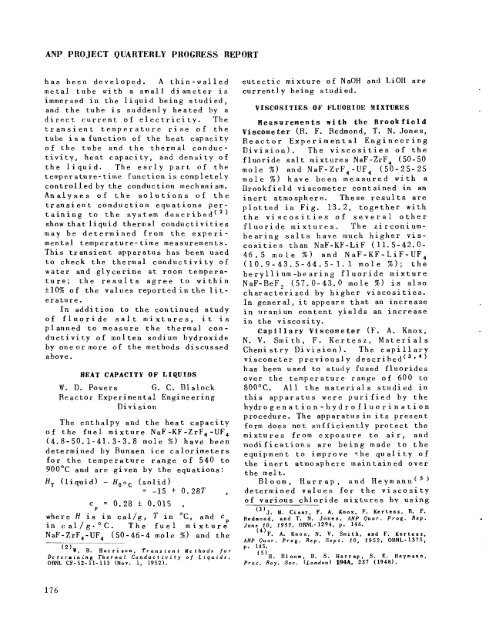the Molten Salt Energy Technologies Web Site
the Molten Salt Energy Technologies Web Site
the Molten Salt Energy Technologies Web Site
Create successful ePaper yourself
Turn your PDF publications into a flip-book with our unique Google optimized e-Paper software.
ANP PROJECT QUARTERLY PROGRESS REPORT<br />
has been developed. A thin-walled<br />
metal tube with a small diameter is<br />
immersed in <strong>the</strong> liquid being studied,<br />
and <strong>the</strong> tube is suddenly heated by a<br />
direct current of electricity. The<br />
transient temperature rise of <strong>the</strong><br />
tube is a function of <strong>the</strong> heat capacity<br />
of <strong>the</strong> tube and <strong>the</strong> <strong>the</strong>rmal conduc-<br />
tivity, heat capacity, and density of<br />
<strong>the</strong> liquid. The early part of <strong>the</strong><br />
temperature-time function is completely<br />
controlled by <strong>the</strong> conduction mechanism.<br />
Analyses of <strong>the</strong> solutions of <strong>the</strong><br />
transient conduction equations per-<br />
taining to <strong>the</strong> system described(')<br />
show that 1 i quid <strong>the</strong>rm a 1 conduct ivi ti e s<br />
may he determined from <strong>the</strong> experi-<br />
mental temperature- time measuremenLs.<br />
This transient apparatus has been used<br />
to check <strong>the</strong> <strong>the</strong>rmal conductivity of<br />
water and glycerine at. room tempera-<br />
ture; <strong>the</strong> results agree to within<br />
+lo% of <strong>the</strong> values reported in <strong>the</strong> lit-<br />
erature.<br />
In addition to <strong>the</strong> continued study<br />
of fluoride salt mixtures, it is<br />
planned to measure<br />
ductivity of molten<br />
by oneor more of <strong>the</strong><br />
above.<br />
HEAT CAPACITY<br />
<strong>the</strong> <strong>the</strong>rmal con-<br />
sodium hydroxide<br />
met hods d i s cus sed<br />
OF LIQUIDS<br />
W. D. Powers<br />
G. C. Blalock<br />
Re act 0 r Expe rime n t a1 Engineering<br />
Division<br />
The enthalpy and <strong>the</strong> heat capacity<br />
of <strong>the</strong> fuel mixture NaF-KF-ZrF, -UF,<br />
(4.8-50.1-41.3-3.8 mole %) have been<br />
determined by Bunsen ice calorimeters<br />
for <strong>the</strong> temperature range of 540 to<br />
900°C and are given by <strong>the</strong> equations:<br />
H, (liquid) - HOoC (solid)<br />
= -15 + 0.28T ,<br />
c = 0.28 f 0.015 ,<br />
P<br />
where H is in cal/g, 7' in OC, and cP<br />
in cal/g-OC. The fuel mixture<br />
NaF-ZrF4-UF, (50-46-4 mole %) and <strong>the</strong><br />
(2)W. 8. Harrison, Transient Methods for<br />
Determining Thermal Conductivrty of Liquids,<br />
OWL CF-52-11-113 (Nor. 1, 1952).<br />
176<br />
eutectic mixture of NaOH and LiOII are<br />
currently being studied.<br />
VISCOSITPES OF FLUORIDE MIXTURES<br />
measurements with <strong>the</strong>! Brook field<br />
Viscometer (R. F. Redmond, T. N. Jones,<br />
Reactor Experimental Engineering<br />
Division). The viscosities of <strong>the</strong><br />
fluoride salt mixtures NaF-ZrF4 (SO-SO<br />
mole %) and NaF-ZrF,-UF, (50-25-25<br />
mole %) have been measured with a<br />
Brookfield viscometer contained in an<br />
inert atmosphere. These results are<br />
plotted in Fig. 13.2, toge<strong>the</strong>r with<br />
<strong>the</strong> viscosities of several o<strong>the</strong>r<br />
f 1 uori de mixtures. The zirconiumbearing<br />
salts have much higher viscosities<br />
than NaF-KF-LiF (11.5-42.0-<br />
46.5 mole %) and NaF-KF-LiF-UF,<br />
(10.9-43.5-4'4.5-1, 1 mole %); <strong>the</strong><br />
beryllium-bearing fluoride mixture<br />
NaF-BeF, (57.0-43.0 mole %) is also<br />
characterized by higher viscosities.<br />
In general, it appears that an increase<br />
in uranj urn content yields an increase<br />
in <strong>the</strong> viscosity.<br />
Capillary Viscometer (F. A. Knox,<br />
N. V. Smith, F. Kertesz, Materials<br />
Chemi stry Di vi sion) . The c api 11 ary<br />
viscometer previously<br />
has been used to study fused fluorides<br />
over <strong>the</strong> temperature range of 600 to<br />
800°C. All <strong>the</strong> materials studied in<br />
this apparatus were purified by <strong>the</strong><br />
hydrogen at i o n - hyd r o f 1 u o r i n at i on<br />
procedure. The apparatus in its present<br />
form does not sufficiently protect <strong>the</strong><br />
mixtures from exposure to air, and<br />
modifications are being made to <strong>the</strong><br />
equipment to improve <strong>the</strong> quality of<br />
<strong>the</strong> inert atmosphere maintained over<br />
<strong>the</strong> melt.<br />
Bloom, Harrap, and Heymann(')<br />
determined values for <strong>the</strong> viscosity<br />
of various chloride<br />
__ mixtures by using<br />
(3)J. M. Ciaar, F. A. Knox, F. Kertesz, R. F.<br />
Redaond, and T. N. Jones, ANP Quor. Prog. Rep.<br />
June 10, 1952, ORNL-1294, p. 146.<br />
(4)F. A. Knox, N. V. Smith, and F. Kertesz.<br />
ANP Quar. Prog. Rep. Sept. 10, 1 952, ORNL-1375,<br />
p. 145.<br />
("H. Bloom, B. S. Harrap, S. E. Neymann,<br />
Proc. Roy. SOC. (London) 194.4, 237 (1948).



![Review of Molten Salt Reactor Physics Calculations [Disc 2]](https://img.yumpu.com/21979492/1/190x247/review-of-molten-salt-reactor-physics-calculations-disc-2.jpg?quality=85)












